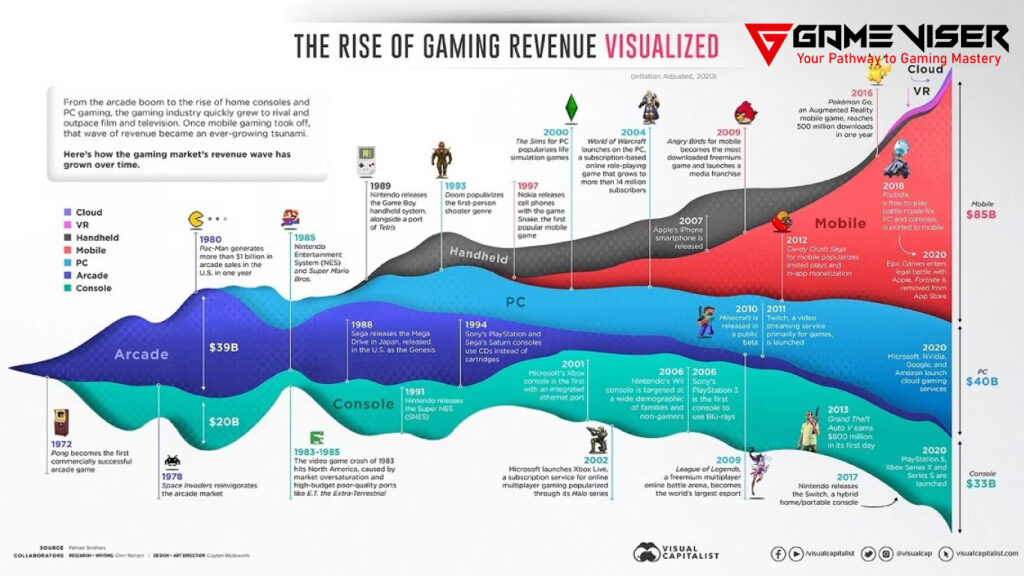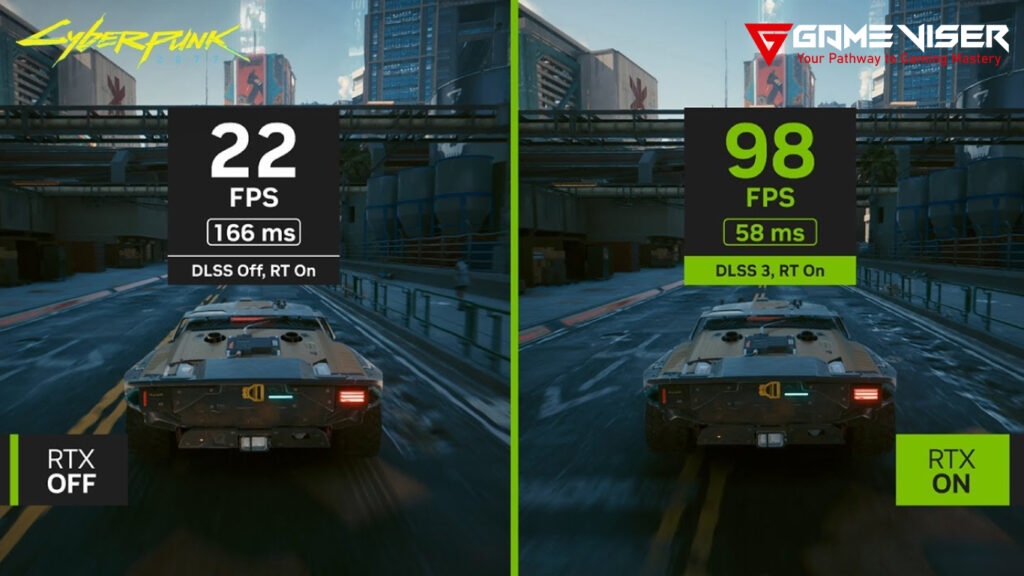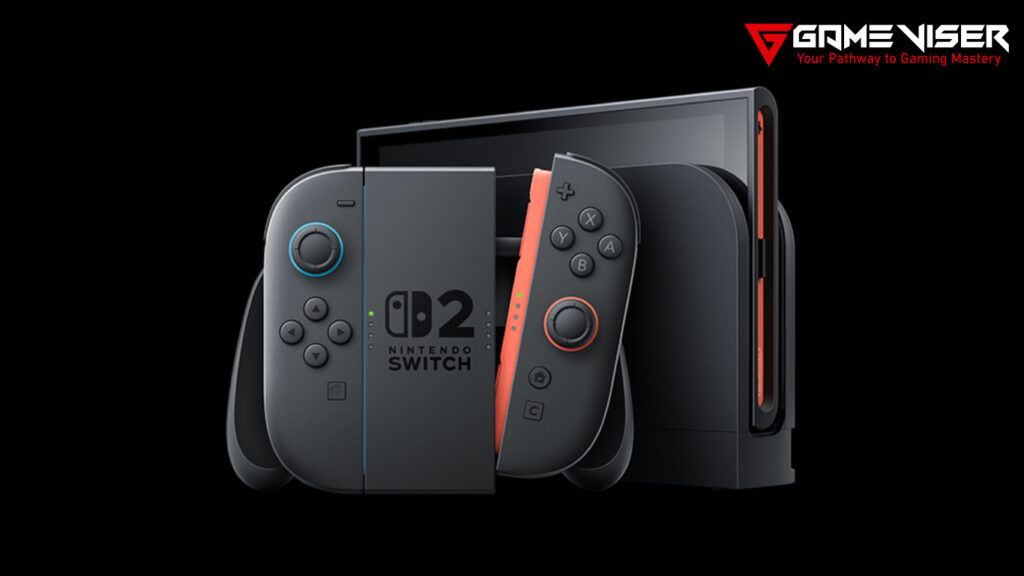Discover generative AI in gaming: how AI shapes worlds, NPCs, and stories in 2025. Explore its impact, tools, and future with GameViser’s guide to next-gen gaming.
Table of Contents
Introduction
The gaming industry is at a turning point, captivating over 3.3 billion players worldwide and pushing technological boundaries. In 2025, generative AI in gaming is a blazing-hot topic, transforming how games are designed, played, and experienced. From crafting dynamic open worlds to generating lifelike NPC interactions and personalized narratives, generative AI is redefining creativity and immersion. As consoles like the Nintendo Switch 2 and platforms like Xbox Cloud Gaming embrace this tech, the possibilities are endless.

This comprehensive guide, brought to you by GameViser, explores how generative AI is reshaping gaming. We’ll cover its applications, key tools, benefits, challenges, and future trends, backed by data-driven insights with tables for clarity. Whether you’re a gamer, developer, or tech enthusiast, here’s everything you need to know about the AI-driven gaming revolution.
What is Generative AI in Gaming?
Generative AI refers to artificial intelligence systems that create content—text, images, audio, or 3D models—based on patterns learned from vast datasets. In gaming, it’s used to generate dynamic environments, realistic characters, adaptive storylines, and even music, reducing development time and enhancing player experiences. Unlike traditional scripting, generative AI enables games to evolve in real time, responding to player actions with unprecedented depth.

For example, AI tools like NVIDIA’s DLSS enhance visuals, while platforms like Unity’s Muse help developers craft assets on the fly. As Gartner predicts, 50% of game studios will use generative AI by 2026, making it a cornerstone of modern gaming.
Why Generative AI is Transforming Gaming
Generative AI is gaining traction due to its ability to address industry challenges and meet player expectations. A 2024 Deloitte survey found that 72% of gamers crave more personalized experiences, which AI delivers through tailored narratives and dynamic worlds. Developers benefit from faster prototyping and lower costs, while studios face pressure to innovate amid rising budgets—AAA games now average $200 million to produce.
Regulatory shifts, like the EU’s AI Act, ensure ethical AI use, boosting consumer trust. For gamers, AI means richer, more immersive games; for studios, it’s a competitive edge. Learn more about gaming tech trends at GameViser’s Industry Insights.
Key Applications of Generative AI in Gaming
Generative AI is revolutionizing multiple facets of game development and gameplay. Here’s how it’s making waves in 2025:
Procedural World Generation
Generative AI creates vast, dynamic game worlds that adapt to player actions. Games like No Man’s Sky pioneered procedural generation, but 2025 titles take it further. For instance, Ubisoft’s rumored open-world RPG uses AI to generate unique landscapes, weather patterns, and ecosystems in real time, ensuring no two playthroughs are identical. Tools like Epic’s Unreal Engine Nanite leverage AI to render detailed environments efficiently.
Intelligent NPCs
Non-player characters (NPCs) are smarter than ever, thanks to generative AI. Instead of scripted responses, NPCs in games like Starfield 2 use AI models like xAI’s Grok to engage in natural, context-aware dialogue. These NPCs adapt to player choices, creating immersive interactions. NVIDIA’s Avatar Cloud Engine powers lifelike facial animations, enhancing realism.
Dynamic Storytelling
Generative AI crafts branching narratives that evolve based on player decisions. In Larian Studios’ next RPG, AI generates unique quests and dialogue, offering personalized stories. This builds on successes like Baldur’s Gate 3, where player agency was key. OpenAI’s ChatGPT-inspired models are integrated into game engines, enabling real-time narrative adjustments.
Asset Creation
AI streamlines asset creation, from textures to 3D models. Tools like Unity Muse and Adobe Firefly generate high-quality assets in minutes, cutting development time by up to 40%, per Unity’s 2024 report. Indie studios, in particular, benefit, creating AAA-quality visuals on smaller budgets.
Adaptive Audio
Generative AI composes dynamic soundtracks that shift with gameplay. Sony’s AI audio engine, used in PS5 Pro titles, generates music that reacts to player actions, enhancing immersion. AI-driven voice synthesis also creates realistic character voices, reducing reliance on costly voice actors.
Generative AI Applications in Gaming (2025)
| Application | Description | Key Tools/Platforms | Impact |
|---|---|---|---|
| Procedural World Gen | Creates dynamic, unique game environments | Unreal Engine Nanite, Unity Muse | Enhances replayability, cuts dev time |
| Intelligent NPCs | Enables context-aware NPC interactions | NVIDIA ACE, xAI Grok | Boosts immersion, realism |
| Dynamic Storytelling | Generates adaptive, player-driven narratives | OpenAI models, Larian AI scripts | Personalizes player experience |
| Asset Creation | Automates textures, models, and animations | Unity Muse, Adobe Firefly | Reduces costs, speeds production |
| Adaptive Audio | Composes reactive music and voices | Sony AI Audio, AIVA | Deepens immersion, lowers costs |
Generative AI in Major 2025 Games
Generative AI shines in 2025’s biggest titles, showcasing its potential:
- Nintendo Switch 2’s Mario Kart World: AI generates dynamic race tracks in an open-world Mushroom Kingdom, adapting layouts based on player skill. NVIDIA’s DLSS enhances visuals on the Switch 2’s OLED screen.
- Starfield 2: Bethesda uses AI-driven NPCs powered by Microsoft Azure AI to create unique planetary cultures, with dialogue that evolves based on player choices.
- Cyberpunk 2077: Neon Dawn: CD Projekt Red’s sequel leverages AI to generate procedurally evolving city districts, with NVIDIA ACE powering lifelike NPC interactions.
- Indie Hit: Echoes of Tomorrow: This indie RPG uses Unity Muse to craft unique quests and environments, proving AI’s accessibility for smaller studios.

Benefits of Generative AI in Gaming
Generative AI offers transformative advantages:
- Enhanced Immersion: AI-driven worlds, NPCs, and stories create deeper, more engaging experiences, as seen in Starfield 2.
- Cost Efficiency: AI reduces development costs by automating asset creation and scripting, saving studios up to 30%, per GamesIndustry.biz.
- Faster Development: Tools like Adobe Firefly cut prototyping time, enabling faster releases.
- Personalization: Dynamic narratives tailor experiences to individual players, boosting engagement, as noted in Deloitte’s 2024 gaming report.
- Accessibility for Indies: AI tools democratize development, letting small teams compete with AAA studios.
These benefits make generative AI a game-changer for developers and players alike.
Challenges of Generative AI in Gaming
Despite its promise, generative AI faces hurdles:
- Ethical Concerns: AI-generated content raises issues of originality and copyright, with debates over training data, as highlighted by the WIPO AI report.
- Performance Overhead: Real-time AI processing can strain hardware, requiring optimization, especially on consoles like the Xbox Series X/S.
- Quality Control: AI-generated assets may lack polish, requiring human oversight to ensure consistency, per Unity’s 2024 findings.
- Player Trust: Overreliance on AI could alienate players who value handcrafted experiences.
- Regulatory Compliance: The EU’s AI Act mandates transparency, adding complexity for studios.
Addressing these challenges is key to AI’s long-term success in gaming.
Generative AI Tools for Game Development (2025)
| Tool | Provider | Function | Key Features | Use Case |
|---|---|---|---|---|
| Unity Muse | Unity | Asset creation, world gen | Real-time texture/model generation | Indie/AAA environment design |
| NVIDIA ACE | NVIDIA | NPC dialogue, animations | Lifelike facial expressions, voice synth | NPC interactions in RPGs |
| Adobe Firefly | Adobe | Texture, concept art generation | High-res asset creation, style transfer | Rapid prototyping for studios |
| Sony AI Audio | Sony | Dynamic music, voice synthesis | Adaptive soundtracks, realistic voices | Audio design in PS5 titles |
| Unreal Engine Nanite | Epic Games | Procedural world rendering | Micro-polygon geometry, AI optimization | Open-world game development |
Visualizing AI’s Impact: Data Insights
Generative AI’s influence is quantifiable:
- Adoption Rates: Gartner estimates 50% of game studios will use generative AI by 2026, up from 20% in 2023.
- Cost Savings: AI cuts development costs by 30% for AAA titles, per GamesIndustry.biz, enabling more experimental games.
- Player Engagement: AI-driven personalization boosts playtime by 25%, according to Deloitte’s 2024 survey.
- Indie Growth: AI tools have increased indie game releases by 15% since 2023, per Steam’s 2024 data.
How Gamers Benefit from Generative AI
Generative AI enhances the player experience in 2025:
- Unique Playthroughs: AI-driven worlds and stories, as in Mario Kart World, ensure every session feels fresh.
- Immersive Interactions: Smarter NPCs in Starfield 2 create lifelike social dynamics.
- Affordable Games: AI’s cost savings could lower game prices, benefiting budget-conscious players.
- Diverse Content: Indies using AI tools release innovative titles, expanding genre variety on platforms like Steam.
The Future of Generative AI in Gaming
By 2030, generative AI could dominate gaming. Expect:
- Fully AI-Driven Games: Titles where entire campaigns are generated in real time, building on Larian’s RPG experiments.
- Cross-Platform Integration: AI syncing experiences across cloud gaming platforms and consoles.
- Ethical Standards: Stricter regulations, like the EU AI Act, will ensure transparent AI use.
- Player-Created Content: AI tools enabling gamers to design levels or stories, as explored in GameViser’s Modding Guide.
Conclusion
Generative AI in gaming is reshaping the industry in 2025, delivering dynamic worlds, intelligent NPCs, and personalized stories that captivate players. From the Nintendo Switch 2’s AI-enhanced tracks to indie gems powered by Unity Muse, this technology is driving innovation while cutting costs. Despite challenges like ethics and performance, the benefits—immersion, efficiency, and accessibility—are undeniable. Gamers and developers alike can embrace this revolution, crafting and enjoying experiences that push boundaries.
FAQs
What is generative AI in gaming?
It’s AI that creates dynamic game content like worlds, NPCs, and stories, enhancing immersion, as seen in Starfield 2.
How does generative AI benefit gamers?
It offers unique playthroughs, smarter NPCs, and diverse games, improving experiences on platforms like the PS5 Pro.
Which 2025 games use generative AI?
Titles like Mario Kart World and Cyberpunk 2077: Neon Dawn leverage AI for dynamic content.
What tools power generative AI in games?
Unity Muse, NVIDIA ACE, and Adobe Firefly are key, as detailed in GameViser’s Tech Guide.
Are there ethical concerns with AI in gaming?
Yes, issues like copyright and transparency arise, governed by laws like the EU AI Act.
Can generative AI make games cheaper?
By cutting development costs by up to 30%, AI could lower prices, per GamesIndustry.biz.
What’s the future of AI in gaming?
Expect fully AI-driven games and player-created content by 2030, as explored in GameViser’s Industry Trends.




